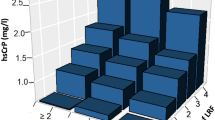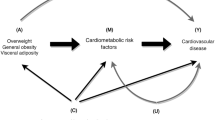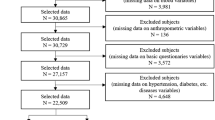Abstract
Background and aim:
Adiponectin is considered by many to be part of the ‘common soil’ linking type 2 diabetes and coronary heart disease (CHD). We examined the relationship between adiponectin and insulin resistance, metabolic, inflammatory and haemostatic risk factors and hepatic function.
Methods and results:
The study was carried out in 3640 non-diabetic men aged 60–79 years drawn from general practices in 24 British towns and who were not on warfarin. Adiponectin was associated with waist circumference (inversely), alcohol intake (positively) and physical activity (nonlinearly); no association was seen with cigarette smoking, prevalent CHD or stroke. After adjustment for these factors, adiponectin was significantly inversely associated with insulin resistance, triglyceride, C-reactive protein (but not interleukin 6), tissue plasminogen activator and alanine aminotransferase and positively associated with high-density lipoprotein cholesterol (HDL-cholesterol) and Factor VIII, factors associated with diabetes. No association was seen with cholesterol, smoking, systolic blood pressure or coagulation factors. Risk of the metabolic syndrome decreased significantly with increasing adiponectin.
Conclusion:
Adiponectin is inversely associated with factors strongly associated with the development of diabetes. Limited associations with the established major risk factors for CHD suggest adiponectin may be a stronger marker of risk for diabetes than for CHD.
This is a preview of subscription content, access via your institution
Access options
Subscribe to this journal
Receive 12 print issues and online access
$259.00 per year
only $21.58 per issue
Buy this article
- Purchase on Springer Link
- Instant access to full article PDF
Prices may be subject to local taxes which are calculated during checkout


Similar content being viewed by others
References
Scherer PE, Williams S, Fogliano M, Baldini G, Lodish HF . a novel serum protein similar to C1q, produced exclusively in adipocytes. J Biol Chem 1995; 270: 26746–26749.
Chandran M, Phillips SA, Ciaraldi T, Henry RR . Adiponectin: More than just another fat cell hormone? Reviews/Commentaries. Diabetes Care 2003; 26: 2442–2450.
Weyer C, Funahashi T, Tanaka S, Hotta K, Matsuzawa Y, Pratley RE et al. Hypoadiponectinemia in obesity and type 2 diabetes: close association with insulin resistance and hyperinsulinemia. J Clin Endocrinol Metab 2001; 86: 1930–1935.
Trujillo ME, Scherer PE . Adiponectin – journey from an adipocyte secretory protein to biomarker of the metabolic syndrome. J Intern Med 2005; 257: 167–175.
Ouchi N, Kihara S, Funahashi T, Matsuzawa Y, Walsh K . Obesity, adiponectin and vascular inflammatory disease. Curr Opin Lipidol 2003; 14: 561–566.
Ouchi N, Kihara S, Arita Y, Okamoto Y, Maeda K, Kuriyama H et al. Adiponectin, an adipocyte derived plasma protein, inhibits endothelial NF-κB signalling through a cAMP-dependent pathway. Circulation 2000; 102: 1296–1301.
Ouchi N, Kihara S, Arita Y, Maeda K, Kuriyama H, Okamoto Y et al. Novel modulator for endothelial adhesion molecules: adipocyte-derived plasma protein adiponectin. Circulation 1999; 100: 2473–2476.
Goldstein BJ, Scalia R . Adiponectin: a novel adipokine linking adipocytes and vascular function. J Clin Endocrinol Metab 2004; 89: 2563–2568.
Ross R . Atherosclerosis – an inflammatory disease. N Engl J Med 1999; 340: 115–126.
Pickup JC . Inflammation and activated innate immunity in the pathogenesis of type 2 diabetes. Diabetes Care 2004; 27: 813–823.
Spranger J, Kroke A, Mohlig M, Bergmann MM, Ristow M, Boeing H et al. Adiponectin and protection against type 2 diabetes mellitus. Lancet 2003; 361: 226–228.
Daimin M, Oizumi T, Saitoh T, Kameda W, Hirata A, Yamaguchi H et al. Decreased serum levels of adiponectin are a risk factor for the progression to type 2 diabetes in the Japanese Population. Diabetes care 2003; 26: 2015–2020.
Snehalatha C, Mukesh B, Simon M, Viswanathan V, Haffner SM, Ramachandran A . Plasma adiponectin is an independent predictor of type 2 diabetes in Asian Indians. Diabetes Care 2003; 26: 3226–3229.
Krakoff J, Funahashi T, Stehouwer CD, Schalkwijk CG, Tanaka S, Matzusawa Y et al. Inflammatory markers, adiponectin and risk of type 2 diabetes in the Pima Indian. Diabetes Care 2003; 26: 1745–1751.
Duncan BB, Schmidt MI, Pankow JS, Bang H, Couper D, Ballantyne CM et al. Adiponectin and the development of type 2 diabetes: The Atheroschlerosis Risk in Communities Study. Diabetes 2004; 53: 2473–2478.
Choi KM, Lee J, Lee KW, Seo JA, Oh JH, Kim SG et al. Serum adiponectin concentrations predict the developments of type 2 diabetes and the metabolic syndrome in elderly Koreans. Clin Endocrin 2004; 61: 75–80.
Kumada M, Kihara S, Sumitsuji S, Kawamoto T, Matsumoto S, Ouchi N, et al., for the Osaka CAD Study Group. Association of hypoadiponectinemia with coronary artery disease in men. Arterioscl Throm Vasc Biol 2003; 23: 85–89.
Kojima S, Funahashi T, Sakamoto T, Miyamoto S, Soejima H, Hokamaki J et al. The variation of plasma concentrations of a novel, adipocyte derived protein, adiponectin, in patients with acute myocardial infarction. Heart 2003; 89: 667.
Pischon T, Girman CJ, Hotamisligil GS, Rifai N, Hu F, Rimm EB . Plasma adiponectin levels and risk of myocardial infarction in men. JAMA 2004; 291: 1730–1737.
Lindsay RS, Resnick HE, Zhang Y, Best LG . Adiponectin and coronary heart disease: The Strong Heart Study. Arterioscler Thromb Vasc Biol 2005; 25: e6–e15.
Rothenbacher D, Brenner H, Marz W, Koenig W . Adiponectin, risk of coronary heart disease and correlation with cardiovascular risk markers. Eur Heart J 2005; 26: 1640–1646.
Lawlor DA, Smith GD, Ebrahim S, Thompson C, Sattar N . Plasma adiponectin levels are associated with insulin resisatnce but do not predict future risk of coronary heart disease in women. J Clin Endocrinol Metab 2005; 90: 5677–5683.
Lihn AS, Pedersen SB, Richelsen B . Adiponectin: action, regulation and association to insulin sensitivity. Obesity Rev 2005; 6: 13–21.
Stern MP . Diabetes and cardiovascular disease. The ‘common soil’ hypothesis. Diabetes 1995; 44: 369–374.
Abbasi F, Chu JW, Lamendola C, McLaughlin T, Hayden J, Reaven GM et al. Discrimination between obesity and insulin resistance in the relationship with adiponectin. Diabetes 2004; 53: 585–590.
Cnop M, Havel PJ, Utzschneider KM, Carr DB, Sinha MK, Boyko EJ et al. Relationship of adiponectin to body fat distribution, insulin sensitivity and plasma lipoproteins: evidence for independent roles of age and sex. Diabetologia 2003; 46: 459–469.
Hulthe J, Hulten LM, Fagerberg B . Low adipocyte-derived plasma protein adiponectin concentrations are associated with the metabolic syndrome and small dense low-density lipoprotein particles: Atherosclerosis and Insulin Resistance Study. Metabolism 2003; 52: 1612–1614.
Yamamoto Y, Hirose H, Saito I, Tomita M, Taniyama M, Matsubara K . Correlation of the adipocyte-derived protein adiponectin with insulin resistance index and serum high-density lipoprotein-cholesterol, independent of body mass index, in the Japanese population. Clin Sci (Lond) 2002; 103: 137–142.
Martin LJ, Woo JG, Daniels SR, Goodman E, Dolan LM . The relationships of adiponectin with insulin and lipids are strengthened with increasing adiposity. J Clin Endocrinol Metab 2005; 90: 4255–4259.
Ouchi N, Kihara S, Funahashi T, Nakamura T, Nishida M, Kumada M et al. Reciprocal Association of C-reactive protein with adiponectin in blood stream and adipose tissue. Circulation 2003; 107: 671–674.
Engeli S, Feldpausch M, Gorzelniak K, Hartwig F, Heintze U, Janke J et al. Association between adiponectin and mediators of inflammation in obese women. Diabetes 2003; 52: 942–947.
Shaper AG, Pocock SJ, Walker M, Cohen NM, Wale CJ, Thomson AG . British Regional Heart Study: cardiovascular risk factors in middle-aged men in 24 towns. BMJ 1981; 282: 179–186.
Wannamethee SG, Lowe GDO, Whincup PH, Rumley A, Walker M, Lennon L . Physical activity and hemostatic and inflammatory variables in elderly men. Circulation 2002; 105: 1785–1790.
Wannamethee SG, Shaper AG, Whincup PH, Walker M . Overweight and obesity and the burden of disease and disability in elderly men. Int J Obes 2004; 28: 1374–1382.
Emberson J, Whincup PH, Walker M, Thomas M, Alberti KG . Biochemical measures in a population based study: the effect of fasting duration and time of day. Ann Clin Biochem 2002; 39: 493–501.
Trinder P . Determination of blood glucose in blood using glucose oxidase with an alternative oxygen acceptor. Ann Clin Biochem 1969; 6: 24–27.
Andersen L, Dinesen B, Jorgensen PN, Poulsen F, Roder MG . Enzyme immunoassay for intact human insulin in serum or plasma. Clin Chem 1993; 39: 578–582.
Matthews DR, Hosker JP, Rudenski AS, Naylor BA, Treacher DF, Turner RC . Homeostasis model assessment: insulin resistance and beta-cell function from fasting plasma glucose and insulin concentrations in man. Diabetologia 1985; 28: 412–419.
Executive Summary of the Third Report of the National Cholesterol Education Program (NCEP) Expert Panel on Detection, Evaluation and Treatment of High Blood Cholesterol in Adults (Adult Treatment Panel III). JAMA 2001; 385: 2486–2497.
Lowe GDO, Rumley A, Norrie J, Ford I, Shepherd J, Cobbe S et al. Blood rheology, cardiovascular risk factors, and cardiovascular disease: the West of Scotland Coronary Prevention Study. Thromb Haemost 2000; 84: 553–558.
Sattar N, Scherbakova O, Ford I, O’Reilly D, Stanley A, Forrest E et al. Elevated ALT predicts new onset type 2 diabetes independently of classical risk factors, metabolic syndrome and c-reactive protein in the West of Scotland Coronary Prevention Study. Diabetes 2004; 53: 2855–2860.
Kriketos AD, Poyten AM, Chisholm DJ, Campbell LV . Exercise increases adiponectin levels and insulin sensitivity in humans. Diabetes Care 2004; 27: 629–630.
Tschritter O, Fritsche A, Thamer C, Haap M, Shirkavand F, Rahe S et al. Plasma adiponectin concentrations predict insulin sensitivity of both glucose and lipid metabolism. Diabetes 2003; 52: 239–243.
Schneider JG, von Eynatten M, Schiekofer S, Nawroth PP, Dugi KA . Low plasma adiponectin levels are associated with increased hepatic lipase activity in vivo. Diabetes Care 2005; 28: 2181–2186.
Sattar N, Gaw A, Scherbakova O, Ford I, O’Reilly DS, Haffner SM et al. Metabolic syndrome with and without c-reactive protein as a predictor of coronary heart disease and diabetes in the West of Scotland Coronary Prevention Study. Circulation 2003; 108: 414–419.
Resnick HE, Jones K, Ruotolo G, Jain AK, Henderson J, Lu W, Howard BV, Strong Heart Study. Insulin resistance, the metabolic syndrome, and risk of incident cardiovascular disease in non-diabetic American Indians. The Strong Heart Study. Diabetes Care 2003; 26: 861–867.
Kopp HP, Kryzanowska K, Mohlig M, Spranger J, Pfeiffer AFH, Schernthaner G . Effects of marked weight loss on plasma levels of adiponectin, markers of chronic subclinical inflammation and insulin resistance in morbidly obese women. Int J Obesity 2005; 29: 766–771.
Nicholls SJ, Rye KA, Barter PJ . High-density lipoproteins as therapeutic targets. Curr Opin Lipidol 2005; 16: 345–349.
Ouchi N, Kihara S, Arita Y, Okamoto Y, Maeda K, Kuriyama H et al. Adiponectin, an adipocyte-derived plasma protein, inhibits endothelial NF-kappaB signaling through a cAMP-dependent pathway. Circulation 2000; 102: 1296–1301.
Ouchi N, Kihara S, Arita Y, Maeda K, Kuriyama H, Okamoto Y et al. Novel modulator for endothelial adhesion molecules: adipocyte-derived plasma protein adiponectin. Circulation 1999; 100: 2473–2476.
Shetty GK, Economides PA, Horton ES, Mantzoros CS, Veves A . Circulating adiponectin and resistin levels in relation to metabolic factors, inflammatory markers and vascular reactivity in diabetic patients and subjects at risk for diabetes. Diabetes Care 2004; 27: 2450–2457.
Yudkin JS, Stehouwer CDA, Emeis JJ et al. C-reactive protein in healthy subjects: associations with obesity, insulin resistance and endothelial dysfunction: a potential role for cytokines originating from adipose tissue. Arterioscler Thromb Vasc Biol 1999; 19: 972–978.
Singhal A, Jamieson N, Fewtrell M, Deanfield J, Lucas A, Sattar N . Adiponectin predicts insulin resistance but not endothelial function in young, healthy adolescents. J Clin Endocrinol Metab 2005; 90: 4615–4621.
Tiikkainen M, Hakkinen AM, Korsheninnikova E, Nyman T, Makimattila S, Yki-Jarvinen H . Effects of rosiglitazone and metformin on liver fat content, hepatic insulin resistance, insulin clearance, and gene expression in adipose tissue in patients with type 2 diabetes. Diabetes. 2004; 53: 2169–2176.
Danesh J, Collins R, Peto R, Lowe GD . Haematocrit, viscosity, erythrocyte sedimentation rate; meta-analysis of prospective studies of coronary heart disease. Eur Heart J 2000; 21: 512–520.
Wannamethee SG, Lowe GDO, Shaper AG, Rumley A, Lennon L, Whincup PH . The metabolic syndrome and insulin resistance: relationship to haemostatic and inflammatory markers in older non-diabetic men. Atherosclerosis 2005; 181: 101–108.
Duncan BB, Schmidt MI, Offenbacher S, Wu KK, Savage PJ, Heiss G, for the ARIC investigators. Factor VIII and other hemostasis variables are related to incident diabetes in adults. The Atherosclerosis Risk in Communities (ARIC) Study. Factor VIII and other hemostasis variables are related to incident diabetes in adults. Diabetes Care 1999; 22: 767–772.
Pinkney JH, Stehouwer CD, Coppack SW, Yudkin JS . Endothelial dysfunction: cause of the insulin resistance syndrome. Diabetes 1997; 46 Suppl 2: S9–S13.
Ferguson MA, White LJ, McCoy S, Kim HW, Petty T, Wilsey J . Plasma adiponectin response to acute exercise in healthy subjects. Eur J Appl Physiol 2004; 91: 324–329.
Acknowledgements
The British Regional Heart Study is a British Heart Foundation Research Group and also receives support from the Department of Health (England). JT and measurements and laboratory analyses in this study were supported by British Heart Foundation Project Grants. The views expressed in this publication are those of the authors and not necessarily those of the Department of Health (England).
Author information
Authors and Affiliations
Corresponding author
Additional information
Conflict of interest
None.
Rights and permissions
About this article
Cite this article
Wannamethee, S., Tchernova, J., Whincup, P. et al. Associations of adiponectin with metabolic and vascular risk parameters in the British Regional Heart Study reveal stronger links to insulin resistance-related than to coronory heart disease risk-related parameters. Int J Obes 31, 1089–1098 (2007). https://doi.org/10.1038/sj.ijo.0803544
Received:
Revised:
Accepted:
Published:
Issue Date:
DOI: https://doi.org/10.1038/sj.ijo.0803544
Keywords
This article is cited by
-
Insights into the Genetic Susceptibility to Type 2 Diabetes from Genome-Wide Association Studies of Obesity-Related Traits
Current Diabetes Reports (2015)
-
Association Between Adiponectin and Heart Failure Risk in the Physicians' Health Study
Obesity (2012)
-
Genetic variation in adiponectin (ADIPOQ) and the type 1 receptor (ADIPOR1), obesity and prostate cancer in African Americans
Prostate Cancer and Prostatic Diseases (2010)
-
Adipokine Effects on Bone
Clinical Reviews in Bone and Mineral Metabolism (2009)
-
Association of adiponectin with mortality in older adults: the Health, Aging, and Body Composition Study
Diabetologia (2009)



